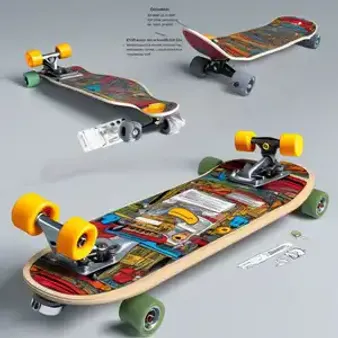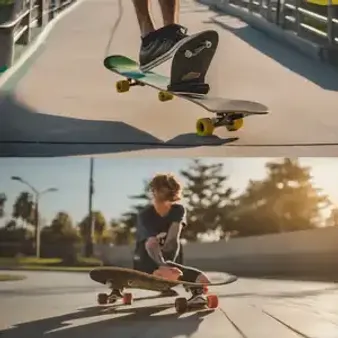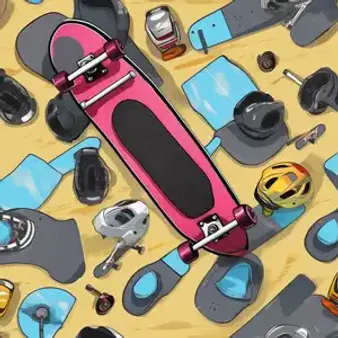Table of Contents
Welcome to kizworld, your one-stop destination for all things skateboarding! Whether you're a complete beginner or a seasoned skater, this comprehensive guide will provide you with everything you need to know about skateboard skating boards. From understanding the different parts of a skateboard to choosing the right one for your needs, we'll cover it all. We'll also delve into the basics of riding and provide essential safety tips to ensure a safe and enjoyable skating experience.
Topic | Key Points |
|---|---|
Skateboard Anatomy | Deck, trucks, wheels, bearings |
Choosing a Skateboard | Consider your riding style, skill level, and budget |
Riding Basics | Pushing, balancing, turning, stopping |
Safety Tips | Wear a helmet and pads, skate in safe areas, be mindful of surroundings |
Skateboard Anatomy: Understanding the Basics of Skateboard Skating Boards
Alright, so you're curious about skateboard skating boards, huh? That's awesome! Let's break down the anatomy of these rolling wonders. Think of a skateboard skating board like a good friend – you gotta know its parts to understand how it moves and grooves.
First up, we've got the "deck," the flat board you stand on. It's usually made of wood, like a super tough popsicle stick, but way cooler. Decks come in different shapes and sizes, kinda like shoes, to fit different riding styles. Next, we have the "trucks," those metal parts that connect the wheels to the deck. They're like the hips of the skateboard, letting it turn and carve. Ever wonder how skateboarders do those sick grinds? Well, it's the trucks that make that magic happen! Trucks have bushings, which are like little rubber cushions that you can adjust to make your ride smoother or tighter. It's all about finding what feels right for you! Finally, we have the "wheels" and "bearings." Wheels are pretty self-explanatory – they're the round things that make you roll! But those tiny bearings inside the wheels are the real MVPs. They let the wheels spin super smoothly, so you can cruise with ease. Think of bearings like tiny ball bearings in a fidget spinner, making everything spin like crazy!
Part | Function |
|---|---|
Deck | The board you stand on, providing the platform for riding. |
Trucks | Metal components that connect the wheels to the deck, allowing for turning and maneuvering. |
Wheels | Round objects that enable the skateboard to roll. |
Bearings | Small, spherical components within the wheels that facilitate smooth and efficient rolling. |
Now that you know the basic parts, let's talk about how they work together. Imagine you're pushing off the ground – that force goes from your foot to the deck, then to the trucks, and finally to the wheels. The bearings inside the wheels help them spin freely, making you go faster and smoother. When you want to turn, you lean your weight on one side, which makes the trucks pivot and the board to carve. It's like magic, but it's actually just physics! To learn more about the best skateboarding boards and trucks, check out our comprehensive guide on skateboarding boards and trucks.
Skateboard Anatomy: Understanding the Basics of Skateboard Skating Boards
Choosing the Right Skateboard Skating Board
Picking the right skateboard skating board can feel like choosing a superpower - it's a big decision! The first thing to think about is what you wanna do with it. Are you dreaming of sick ollies and kickflips at the skatepark? Then you'll want a classic skateboard, like the ones you see in skateboarding movies. These boards have a curved nose and tail, perfect for popping those tricks. If cruising along the beach with the wind in your hair sounds more like your style, then a longboard or cruiser might be your jam. They're longer and wider, making them super stable and comfy for riding longer distances.
Next up, think about your skill level. If you're brand new to the skateboarding game, a beginner board is a great place to start. These boards are usually a bit cheaper and more forgiving as you're learning the ropes. Once you've got the basics down, you can always level up to a more advanced board. It's like learning to ride a bike - you wouldn't start on a unicycle, right? And hey, don't forget about your budget! Skateboard skating boards come in all price ranges, so it's all about finding one that fits your wallet and your riding goals.
Type | Best For |
|---|---|
Classic Skateboard | Tricks and skatepark riding |
Longboard/Cruiser | Cruising and transportation |
Beginner Board | New skaters learning the basics |
Choosing the Right Skateboard Skating Board
Mastering the Basics: How to Ride a Skateboard Skating Board
Alright, so you've got your awesome skateboard skating board all set up – now it's time to learn how to ride this thing! First things first, find a nice, smooth surface like a driveway or an empty parking lot. You don't want to be battling cracks and bumps when you're just starting out. Now, figure out which foot feels more natural to you when you're pushing off the ground. That's gonna be your "pushing foot," while your other foot chills on the board. Think of it like walking, but one foot's taking a break on a rolling platform. Start by practicing your balance – just stand on the board and try to find your center of gravity. It might feel wobbly at first, but you'll get the hang of it. Once you're feeling a bit more stable, give yourself a little push with your pushing foot and see how it feels to roll. Don't worry about going fast yet, just focus on getting comfortable with the movement.
- Coffee
- Tea
- Milk
Mastering the Basics: How to Ride a Skateboard Skating Board
Skateboard Safety: Tips for a Safe and Enjoyable Ride
Safety first! It's like wearing a helmet when you ride your bike – you wouldn't hit the streets without it, right? Same goes for skateboarding! Always gear up with a helmet, and don't forget wrist guards, elbow pads, and knee pads too. Trust me, they're way cooler than scraped knees. Before you start shredding, scope out your surroundings! Find a smooth, open space, like an empty parking lot or a skatepark, where there's plenty of room to practice without any cars or obstacles in the way. It's like learning to swim – you wouldn't jump into the deep end without practicing in the shallows first!
And here's a pro tip from my own skateboarding adventures: always be aware of your surroundings. Look out for pedestrians, other skaters, and anything else that might get in your way. Remember, a little bit of caution goes a long way in preventing accidents and ensuring a fun and safe skating experience. If you're looking to up your skateboarding game, check out our guide on how to do a heelflip.
Safety Gear | Importance |
|---|---|
Helmet | Protects your head from impact in case of a fall. |
Wrist guards | Shield your wrists from sprains and fractures during falls. |
Elbow pads | Cushion your elbows upon impact, reducing the risk of injuries. |
Knee pads | Safeguard your knees from scrapes, bruises, and more serious injuries. |
Skateboard Safety: Tips for a Safe and Enjoyable Ride
Final Thought
Skateboarding is an exhilarating and rewarding activity that offers endless opportunities for fun, creativity, and personal growth. By understanding the basics of skateboard skating boards, choosing the right equipment, mastering fundamental riding techniques, and prioritizing safety, you can embark on an exciting skateboarding journey filled with endless possibilities. Remember to always wear appropriate safety gear, practice regularly, and most importantly, have fun!